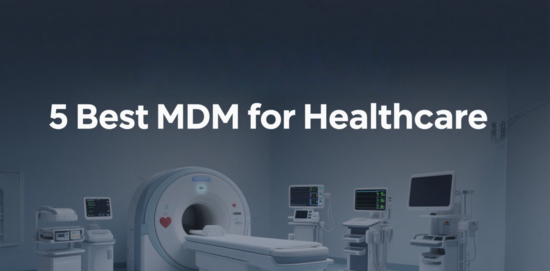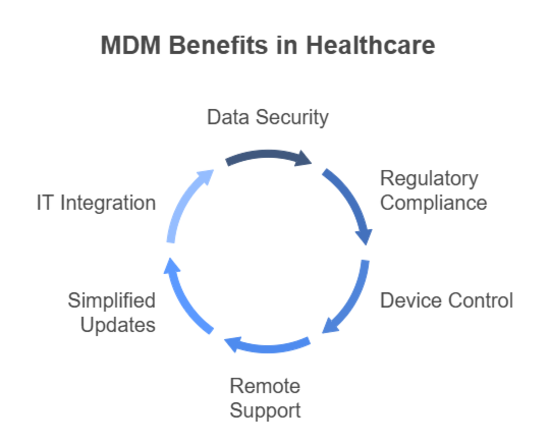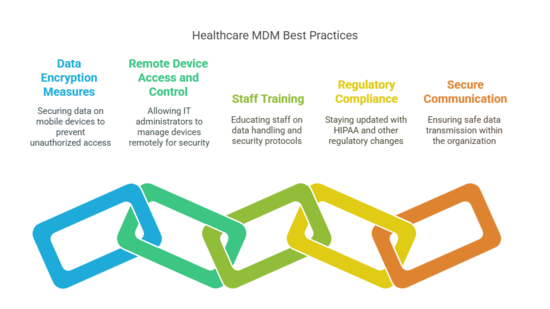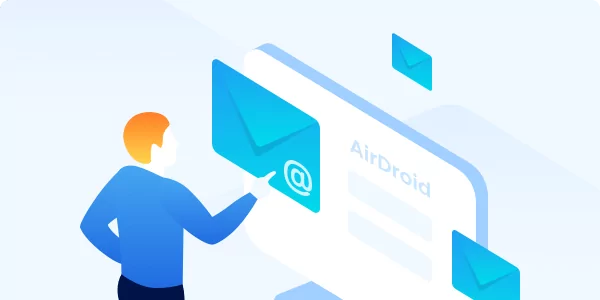5 Best MDM for Healthcare [2025 Updated]
Sensitive healthcare data requires confidentiality and protection. According to the HIPAA Journal report (2024 Healthcare Data Breach Report), 2024 was the worst year for healthcare data breaches, with an all-time high of 276 million data breaches, largely due to the devastating ransomware attack on Change Healthcare. This highlights the critical need for robust data management systems for healthcare providers to ensure maximum security and compliance with strict medical and HIPAA regulations, making strong data governance more essential than ever.
Given this critical landscape, security and compliance are paramount for any healthcare MDM solution. This guide will delve into the 5 best MDM for healthcare in 2025, examining how each addresses these vital needs through advanced security and adherence features, helping healthcare organizations effectively implement MDM.

Part 1: What is MDM in Healthcare?
Mobile Device Management (MDM) solutions are vital for healthcare providers. They help secure sensitive patient information and manage mobile devices (like phones, tablets, and medical equipment) remotely within healthcare facilities, ensuring compliance with regulations like HIPAA while providing seamless access to necessary tools and data for accurate patient care and improved patient outcomes.
Here are MDM's core benefits for healthcare:

1. Data Security: Remotely encrypts and wipes patient data on lost or stolen devices to protect sensitive information.
2. Regulatory Compliance: Helps manage devices to meet strict medical regulations, like HIPAA, ensuring the protection of Protected Health Information (PHI) by identifying vulnerabilities and enforcing policies.
3. Device Control: Provides a centralized way to track devices, manage data access (e.g., multi-factor authentication) for healthcare providers, and restrict devices to specific uses (kiosk mode). This comprehensive control is vital to protect patient data.
4. Remote Support: Allows IT teams to control and troubleshoot devices from anywhere, minimizing downtime.
5. Simplified Updates: Centrally manages OS and healthcare application updates, keeping all devices secure and current.
6. IT Integration: Designed to work smoothly with other healthcare IT systems (like EHRs) for better data flow.
Part 2. 5 Best MDM Software for the Healthcare Industry
These are the 5 MDM solutions designed for healthcare operations, each chosen for its ability to protect sensitive data while streamlining device management.
1. AirDroid Business
💡 Best for: Healthcare organizations focused on granular management and remote support for Android devices
Airdroid Business is particularly beneficial for telemedicine, mobile nursing, and field service scenarios. Its robust remote control, kiosk and policy strategy, file transfer, and geofencing features, combined with its support for HIPAA compliance, make it excellent for managing dedicated or shared devices like patient tablets or mobile diagnostic equipment.
Pros✅
- Remote access and control for troubleshooting without any physical involvement
- Robust device provisioning & enrollment (provide different methods like (QR code, Android Enterprise, Zero-Touch, USB)
- Secure Kiosk mode & policy control
- Remote control & remote support
- Real-time device location tracking & set up geofences with automated alerts
- Flexible Application Management Service (AMS) with staged rollouts & Organization App Library
Cons❌
- Mainly supports Android and Windows devices, not suitable for organizations that need to uniformly manage iOS or macOS devices
- Do not support automate backup
2. Jamf
💡 Best for: Healthcare organizations primarily utilizing Apple devices (iPhones, iPads, Macs)
Jamf is ideal for larger enterprises and those with high demands for deep integration within the Apple ecosystem. Jamf excels in zero-touch deployment, application management, security policy enforcement, and unified management of Apple devices, making it perfect for doctors, nurses, and other staff using Apple products for work.
Pros✅
- Its self-service portal gives end users access to approved apps and resources without IT complications
- Jamf centralized dashboard gives granular policy control by enforcing polices, restrictions, and configurations
- It has an Apple-centric design in terms of compatibility and feature depth
- Jamf has extensive support resources, including documentation, a forum, and responsive customer support
Cons❌
- It is an Apple-oriented platform not fit for organizations having a batch of Android and Windows devices
- Potential feature overkill - while powerful, some of its advanced functionalities—such as complex network access controls, or deep custom scripting capabilities—may prove overly complex or unnecessary for smaller organizations with limited Apple device fleets, potentially leading to wasted resources or a steep learning curve
3. ManageEngine Mobile Device Manager Plus
💡 Best for: Healthcare organizations seeking multi-platform MDM with robust BYOD support
ManageEngine Mobile Device Manager Plus is a strong MDM solution for healthcare organizations. It supports multiple operating systems (Android, iOS, Windows, macOS) from a single console, simplifying device management. Its BYOD features, like containerization and selective wipe, help keep corporate and personal data separate, which is crucial for HIPAA compliance. The solution is competitively priced, making it a good fit for organizations that need broad compatibility and cost efficiency. Its intuitive console also makes it easy to deploy and manage.
Pros✅
- Multi-platform support with a unified console
- Simple device enrollment methods, including both self and bulk enrollment support
- Robust security management and remote device troubleshooting functionality
- Advanced applications management feature for in-house and in-store apps
Cons❌
- A complex initial configuration and setup that might be complex to understand for some people
- May offer less customization and complex workflow automation compared to higher-end UEMs
- Some users report intermittent slowdowns, especially with very large device fleets
4. SOTI
💡 Best for: Healthcare organizations managing large fleets of rugged, specialized, or critical medical devices
SOTI MobiControl excels in industrial-grade device management, making it ideal for the often-unique hardware found in healthcare. It offers powerful remote support, advanced geofencing capabilities, and robust features to prevent device loss. This ensures the continuous operation and security of critical medical equipment, from mobile scanners and handheld terminals to specialized diagnostic tools used in demanding environments.
Pros✅
- It provides multi-platform support and compatibility including Android, Windows, macOS, iOS, and Linux
- Designed for large-scale deployments, ensuring stable and efficient management of thousands of devices across complex healthcare networks
- It also comes with deployment flexibility, including cloud-based and on-premises solutions
- IT teams get advanced remote access features to handle network operations from anywhere
Cons❌
- It has a complex interface and requires training for its effective use, user reported that it quite long-winded to configure
- SOTI excels at managing devices, but it doesn't always connect seamlessly with other major IT systems a hospital uses, like those for managing user logins, overall security monitoring, or IT support tickets.
5. NinjaOne
💡 Best for: Healthcare organizations needing robust UEM with IT automation and broad integration
NinjaOne offers healthcare organizations a secure, centralized, and comprehensive unified endpoint management platform. It extends beyond traditional MDM to allow IT teams to manage and automate operations across mobile, desktop, and server devices from a single dashboard. This makes it ideal for the compliance-focused and complex IT environments in hospitals, clinics, and remote care settings. With strong capabilities in patch management, remote monitoring, automated policy deployment, and efficient remote troubleshooting, NinjaOne helps streamline IT operations, reduce security risks, and effectively support HIPAA compliance across all endpoints.
Pros✅
- Offers enhanced patient data security for compliance with medical regulations
- User-friendly design with accessibility for IT teams of any skill level
- It has built-in unified endpoint management functionality for better efficiency
Cons❌
- It has limited reporting features, NinjaOne may offer less flexibility for drag-and-drop custom views, complex filtering, or cross-data source analysis (e.g., correlating device data with user activity logs) compared to more advanced UEM suites.
Part 3. Healthcare MDM Best Practices
Vital patient information requires confidentiality and legal compliance for health organizations. Implementing effective data governance is crucial to guide these efforts. Here are some best MDM practices to consider within a strong governance framework:

1Data Encryption Measures
Encrypting the data (such as patient data) stored on mobile devices adds a security layer. It also restricts unauthorized access to sensitive organization’s data. These devices are termed "safe harbor" and do not require data breach reporting. Implementing robust encryption is a key component of effective data stewardship within healthcare.
2Remote Device Access and Control
IT administrators must have remote access and control over the mobile devices in their network. In case the device is stolen, they will be able to lock the device and erase the sensitive patient data.
3Staff Training
Train the IT staff and employees for smooth operations. Give them awareness about the sensitive data handling and security protocols. It will minimize the chances of any data breach due to human error.
4Keep Up With Regulatory Changes
Stay vigilant about the HIPAA and other regulatory changes. Align your security protocols and data processing to comply with them.
5Secure Communication
Use a secure medium of communication in the organization. Make sure the data transmission is safe and no interception is possible.
Part 4: FAQs
Conclusion
Choosing the right MDM for healthcare solution for your organization is a critical decision. By carefully evaluating your specific requirements, existing IT infrastructure, budget, and the types of devices you manage, you can identify the platform that best aligns with your operational and compliance needs. In today's digital age, robust network and device security is not just an option, but an imperative for protecting healthcare information and ensuring continuous care.
Editor’s Choice
AirDroid Business is a comprehensive MDM choice with scalability options. You can try it for free or contact the support team for further assistance. Network security is no longer a choice in the age of digital security challenges. It also provides a secure and centralized platform to manage all devices. All these make it an excellent choice to help enhance device management and security in an organization.







Leave a Reply.